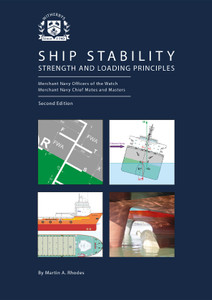
A clear, instructive guide to ship stability for anyone studying to become certified to officer of the watch (OOW) level, this text, with easy to follow worked examples and numerous self-assessment questions, is essential when studying for exams.
Please note: This title also includes access to the 'Stability Information and Tank Sounding Data Book'.
This comprehensive titles covers the ship stability knowledge required for certification to Officer of the Watch level (STCW ’95). Outlining the syllabus requirements if the current SQA examination and HNC level units required for this qualification, it is designed to cover the subject matter in a straightforward, easy to follow way and includes clear worked examples and self-assessment questions throughout.
SECTION 1 INTRODUCTION
SECTION 2 – BASIC PRINCIPLES
2.1 Density, Mass and Volume
2.2 The Laws of Flotation
2.3 Simple box-shaped vessel calculations
Tutorial Questions
SECTION 3 – FORM COEFFICIENTS
3.1 Coefficient of fineness of the water-plane area (Cw)
3.2 Block Coefficient (Cb)
3.3 Midships Coefficient (Cm)
3.4 Longitudinal Prismatic Coefficient (Cp)
Tutorial Questions
SECTION 4 – TONNES PER CENTIMETRE IMMERSIOn
4.1 TPC Formula
4.2 Factors affecting TPC
4.3 Interpolation of hydrostatic data
4.4 Load/Discharge problems
Tutorial Questions
SECTION 5 – LOAD LINES
5.1 Factors for consideration in assigning a freeboard
5.2 Type ‘A’ and Type ‘B’ ships
5.3 Load Line dimensions
5.4 Fresh Water Allowance (FWA)
5.5 Dock Water Allowance (DWA)
5.6 Load Line Calculations
Tutorial Questions
SECTION 6 – CENTRE OF GRAVITY (G) AND CENTRE OF BUOYANCY (B)
6.1 Centre of Gravity
6.2 Effect of shifting a weight already on board
6.3 Effect of loading a weight
6.4 Effect of discharging a weight
6.5 Multiple weight problems
6.6 Centre of buoyancy (B)
Tutorial Questions
SECTION 7 – TRANSVERSE STATICAL STABILIY
7.1 Transverse Statical Stability
7.2 Righting Lever (GZ)
7.3 Moment of statical stability (Righting Moment)
7.4 Initial Transverse Metacentre
7.5 Metacentric Height (GM)
7.6 Calculating the Righting Moment at small angles of heel
Tutorial Questions
SECTION 8 – CONDITIONS OF STABILITY
8.1 Stable Condition
8.2 Neutral Condition
8.3 Unstable condition and angle of loll
Tutorial Questions
SECTION 9 – INITIAL TRANSVERSE METACENTRE
9.1 Initial Transverse metacentre explained
9.2 Calculating KM for a box-shaped vessel
9.3 Use of the metacentre diagram
9.4 To determine the final KG required to complete loading with a required GM
9.5 Factors affecting KM
Tutorial Questions
SECTION 10 – FREE SURFACE EFFECT
10.1 Free surface effect and transverse statical stability
10.2 To calculate the effect of free surface in a rectangular-shaped tank
10.3 Free surface moments
10.4 Representation of free surface data in ship's tank sounding/ullage tables
10.5 Factors influencing free surface effect
Tutorial Questions
SECTION 11 – CURVES OF STATICAL STABILITY (GZ CURVES)
11.1 Calculating GZ Values
11.2 Procedure for constructing a curve of statical stability
11.3 Information available from a curve of statical stability
11.4 Curves of statical stability for stiff and tender ships
Tutorial Questions
SECTION 12 – LIST
12.1 Calculating list caused by transverse shift of weight – the basic list triangle
12.2 Calculating list caused by transverse and vertical shift of weight – ship initially upright
12.3 Calculating the list due to a single weight being loaded or discharged
12.4 Shifting a weight already on board to bring a listed ship upright
12.5 Multiple weight problems – ship initially upright
12.6 Multiple weight problems – ship initially listed
12.7 Loading weight about the centreline to complete upright
12.8 List and free surface effect
Tutorial Questions
SECTION 13 – CURVES OF STATICAL STABILITY FOR VARYING CONDITIONS OF STABILITY
13.1 Curve of statical stability for a ship in a stable condition
13.2 Curve of statical stability for a ship in a neutral condition of stability
13.3 Curve of statical stability for a ship in an unstable condition
13.4 Curve of statical stability for a ship that is listed
13.5 Correcting an angle of loll
Tutorial Questions
SECTION 14 – SUSPENDED WEIGHTS
14.1 Effect on KG lifting a weight using ship's gear
14.2 Loading a weight using ship's lifting gear
14.3 To calculate the maximum permissible KG required prior to loading or discharging a weight to ensure that a certain list limit is not exceeded
Tutorial Questions
SECTION 15 – INTRODUCTION TO TRIM
15.1 Terms relating to ship length
15.2 Draught marks and reading the draught
15.3 Trim
15.4 Change of Trim
15.5 Moment to change trim by one centimetre (MCTC)
15.6 Formula for calculating MCTC
15.7 Longitudinal centre of flotation (LCF or F)
15.8 Calculating the final draughts when a weight is shifted
15.9 The effect of loading and discharging weights
15.10 Multiple weight problems
15.11 Weight to shift to reduce the trim by a specific amount
15.12 Weight to load to bring a ship to an even keel
15.13 Weight to transfer to reduce the deepest draught by a specific amount
Tutorial Questions
SECTION 16 – TRIM USING HYDROSTATIC DATA
16.1 True mean draught – displacement when out of trim
16.2 Calculating the true mean draught
16.3 Trim calculations using hydrostatic data
16.4 Trim by consideration of the relative positions of the LCB and LCG
Tutorial Questions
SECTION 17 – INCLINING EXPERIMENT
17.1 Calculating the KG as inclined
17.2 Calculating the lightship KG and displacement
17.3 Precautions prior to conducting the experiment
17.4 Precautions to ensure accuracy of the calculation
Tutorial Questions
SECTION 18 – ASSESING COMPLIANCE OF A SHIP'S LOADED CONDITION WITH IMO CRITERIA
18.1 Simpson's First Rule
18.2 Simpson's Second Rule
18.3 Intact stability – the relevance of area under the curve of statical stability
Tutorial Questions
SECTION 19 – PRACTICAL SHIP LOADING PROBLEMS
19.1 Introduction to loading sheet data
19.2 Practical ship load problem
Tutorial Questions
- Number of Pages:
- 408
- Published Date:
- August 2009
- Book Height:
- 240 mm
- Book Width:
- 190 mm
- Weight:
- 1.5 kg
- Preview:
- Yes
- Author:
- Martin Rhodes
- Publication Date:
- August 2009






